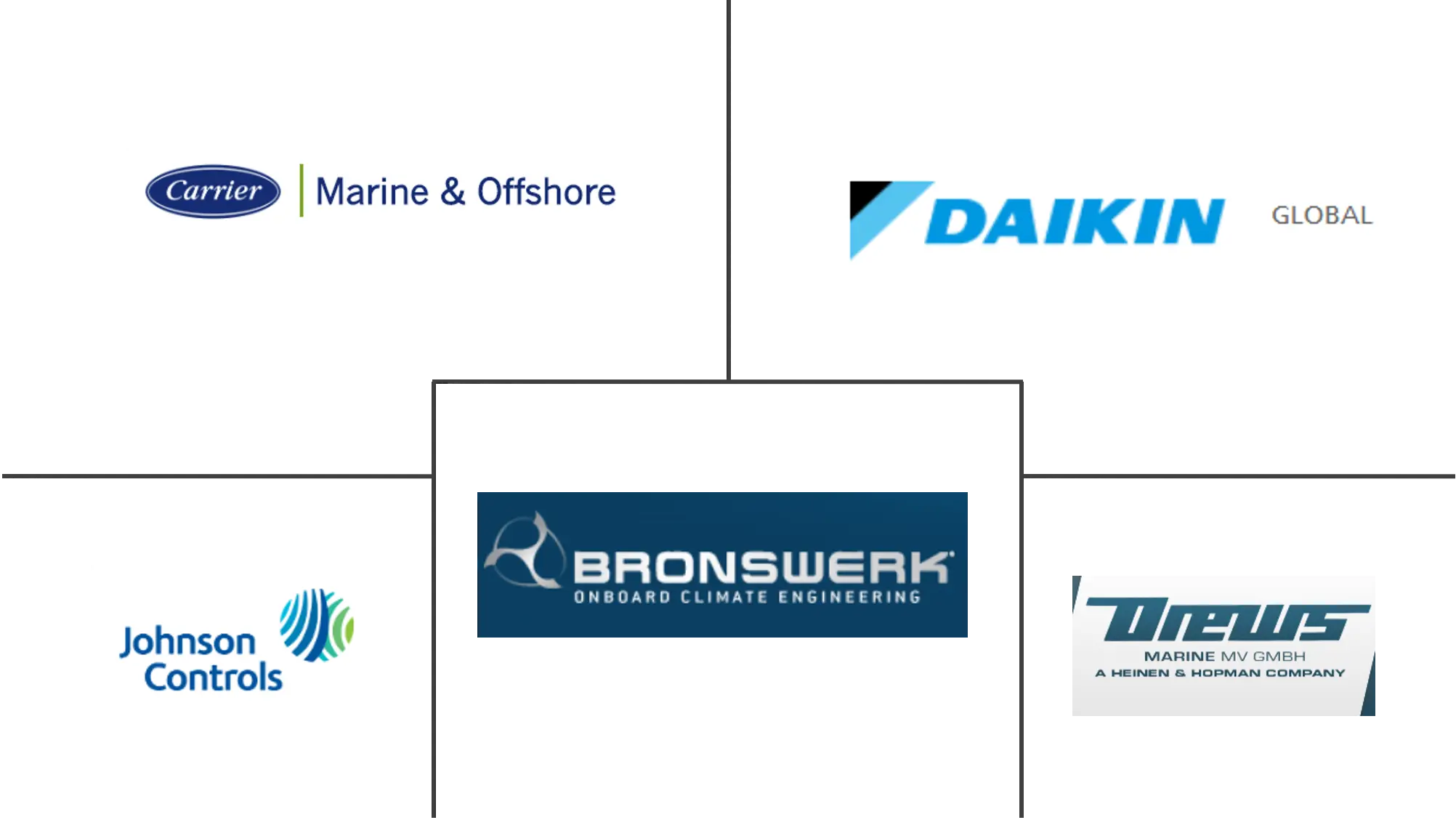Marine Hvac Market Size and Share
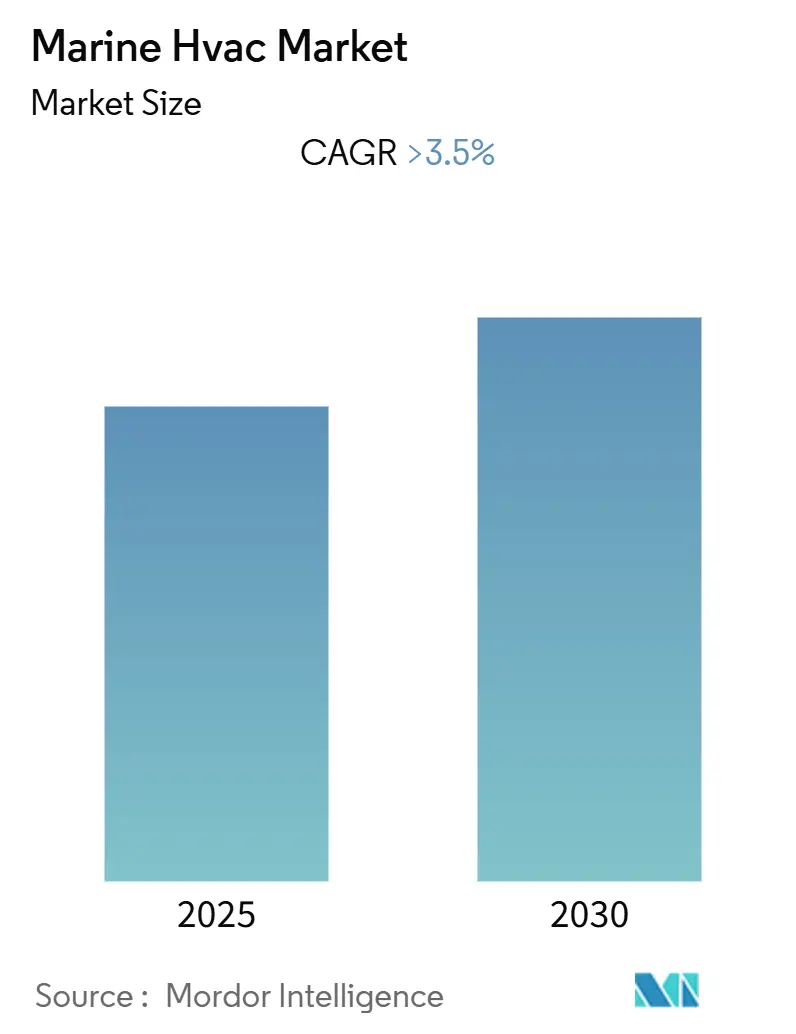
Marine Hvac Market Analysis by Mordor Intelligence
The Marine Hvac Market is expected to register a CAGR of greater than 3.5% during the forecast period.
The marine HVAC industry operates within the broader maritime sector, where significant structural changes are reshaping the competitive landscape. Maritime shipping continues to be the backbone of global trade, exemplified by South Africa, where approximately 67% of the country's total trade value was transported by ships in 2022. The industry's evolution is particularly evident in China, where container throughput reached an impressive 295.9 million twenty-foot equivalent units (TEUs) in 2022, reflecting the growing importance of efficient maritime operations. This increased shipping activity has created a robust demand for sophisticated marine cooling systems that can maintain optimal conditions for both cargo and crew.
The technological landscape of marine HVAC systems is undergoing rapid transformation, with manufacturers focusing on innovation and sustainability. In July 2023, HD Hyundai Heavy Industries achieved a significant breakthrough with their ammonia-based ship HVAC refrigeration system, which received Approval in Principle (AiP) from the ABS classification society. This development represents a major step toward eco-friendly refrigeration solutions, offering zero ozone depletion potential and zero global warming potential. The industry is witnessing a shift toward smart HVAC systems that incorporate advanced control systems, energy optimization algorithms, and predictive maintenance capabilities.
The market is experiencing significant consolidation through strategic acquisitions and partnerships. In May 2023, Daikin Applied strengthened its market position by acquiring Carroll Air Systems, a Florida-based HVAC systems provider, expanding its service capabilities in the marine HVAC market. Similarly, WOZAIR Energy Holdings' acquisition of North Sea Ventilation and Air Conditioning Limited in December 2022 demonstrates the industry's focus on expanding technical capabilities and geographic reach. These strategic moves are reshaping the competitive landscape and driving innovation in marine HVAC solutions.
The shipbuilding industry, which directly influences the marine HVAC market, remains heavily concentrated among three major players: China, South Korea, and Japan, which together controlled approximately 94% of the global shipbuilding market in 2022. This concentration has significant implications for HVAC manufacturers, as they must adapt to the specific requirements and standards of these dominant shipbuilding nations. The industry is witnessing increased emphasis on modular HVAC systems that can be easily integrated into modern shipbuilding processes while meeting stringent environmental regulations and energy efficiency requirements.
Global Marine Hvac Market Trends and Insights
New Shipbuilding to Promote HVAC Demand
The global shipbuilding industry continues to experience significant growth, with China, Japan, and South Korea representing approximately 85% of shipbuilding activity worldwide. China maintains its position as the leading shipbuilder globally, completing ships with a combined gross tonnage of 36.7 million in 2022, followed by South Korea with 23.7 million gross tonnage and Japan with 15.6 million gross tonnage. This surge in shipbuilding activities has created substantial opportunities for marine HVAC systems, as these new vessels require advanced climate control solutions. Governments across various regions are actively investing in enhancing shipbuilding manufacturing facilities, exemplified by the Indian government's sanctioning of USD 20.13 million in March 2022 for manufacturing 47 ships under the Shipbuilding Financial Assistance Policy.
The industry is witnessing a notable shift towards more technologically advanced marine HVAC systems, particularly focusing on eco-friendly solutions. In July 2023, South Korean HD Hyundai Heavy Industries (HHI) obtained Approval in Principle from the classification society ABS for its innovative ammonia-based ship HVAC refrigeration system. This development represents a significant advancement in marine HVAC technology, as the system utilizes ammonia as an eco-friendly refrigerant with zero ozone depletion potential and zero global warming potential. The South Korean government has also implemented initiatives to support the domestic shipbuilding industry, addressing labor shortages by facilitating the entry of approximately 5,500 foreign workers in 2023, with plans to reach 14,000 workers through simplified visa and labor regulations.
Rising Demand for Maritime Tourism and In-House Comfort to Fuel HVAC Demand
The maritime tourism sector has experienced remarkable growth, particularly in the cruise industry, which has witnessed a substantial increase in passenger numbers. In 2022, ocean cruise passengers worldwide reached 20.4 million, marking an extraordinary increase from 4.8 million passengers in 2021. This growth is particularly evident in key markets such as North America, which recorded 12 million ocean cruise passengers in 2022, and Western Europe, which attracted 5.4 million passengers. The expansion of maritime tourism has led to increased demands for sophisticated cruise ship HVAC systems that can maintain optimal comfort levels for passengers across various climate zones and weather conditions.
The industry is experiencing significant developments in cruise infrastructure and facilities, with Singapore recording 441,000 international visitor arrivals by sea in 2022. Mediterranean regions, including Croatia, Greece, Turkey, Italy, and Spain, have emerged as premier destinations for private yacht charters, driving the demand for advanced marine air conditioning systems. Croatia, with its extensive coastline of over 6,000 km and more than 700 islands, has established itself as a significant player in the yachting industry, ranking as the sixth most popular megayacht destination globally in 2021. The country operates 30% of the world's fleet of sailing boats under 16 meters available for hire, demonstrating the growing importance of maintaining comfortable indoor environments in marine vessels through efficient marine air conditioning systems.
Segment Analysis
Cargo Carriers Segment in Marine HVAC Market
The cargo carriers segment dominates the marine HVAC market, commanding approximately 67% market share in 2024, while also demonstrating the strongest growth trajectory with a projected growth rate of around 4% from 2024-2029. This segment's prominence is driven by the increasing cross-border trading activity and rising sea freight volumes, particularly due to the growth of the e-commerce sector. The implementation of various free-trade agreements across nations is contributing significantly to expanding sea trade activity. The capacity of cargo carriers has been steadily increasing to accommodate more seaborne trade, necessitating larger vessels capable of transporting higher volumes in single trips. These vessels require sophisticated marine air conditioning systems to maintain optimal temperatures for temperature-sensitive goods, preventing wastage during long-distance transportation.
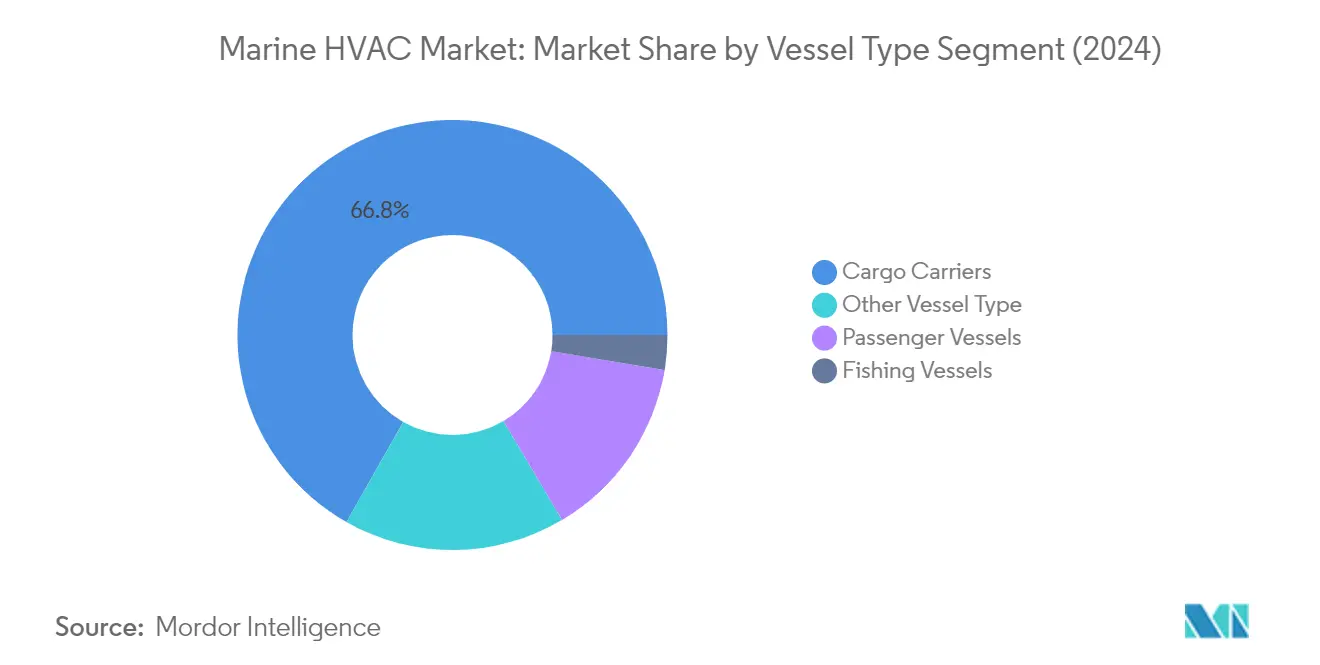
Remaining Segments in Marine HVAC Market by Vessel Type
The marine HVAC market encompasses several other significant vessel segments beyond cargo carriers. Passenger vessels represent a crucial segment, with the demand driven by increasing maritime tourism and the growing emphasis on passenger comfort and safety. The fishing vessels segment, while smaller, maintains steady demand due to the specific marine temperature control requirements for preserving catch quality during operations. The other vessel types category, including specialized vessels like research ships and offshore support vessels, contributes significantly to the market's diversity. Each of these segments presents unique HVAC requirements based on their operational needs, from maintaining comfortable temperatures in passenger areas to ensuring proper marine refrigeration in fishing vessels.
Segment Analysis: By Technology Type
Marine Air Conditioning Segment in Marine HVAC Market
Marine air conditioning systems dominate the marine HVAC market, commanding approximately 54% market share in 2024. This segment's prominence stems from its widespread application across various marine vessels, including superyachts, navy ships, offshore vessels and platforms, passenger vessels, and diverse cargo ships such as container shipping, bulk carriers, and oil tankers. The segment's dominance is further reinforced by the critical role these systems play in maintaining optimal temperature levels while ensuring passenger comfort and cargo preservation. Marine air conditioning systems are particularly vital in controlling humidity levels and preventing corrosion, which is crucial for protecting onboard materials and equipment in harsh maritime environments.
Marine Heating Systems Segment in Marine HVAC Market
The marine heating systems segment is projected to exhibit the strongest growth trajectory in the marine HVAC market from 2024 to 2029, with an expected growth rate of approximately 4%. This accelerated growth is primarily driven by the increasing demand for sophisticated heating solutions in extreme weather conditions, particularly in regions with colder climates. The segment's growth is further supported by technological advancements in energy-efficient heating systems and the rising focus on crew comfort and safety. Marine heating systems manufacturers are increasingly incorporating smart technologies and automated controls, enabling better temperature regulation and energy optimization across different vessel areas.
Remaining Segments in Marine HVAC Technology Type
The marine ventilation systems and marine refrigeration systems segments complete the technology landscape of the marine HVAC market. Marine ventilation systems play a crucial role in maintaining air quality and removing musty air, while also supporting engine performance and equipment functionality. These systems are essential for equalizing humidity levels and ensuring proper air circulation throughout the vessel. Meanwhile, marine refrigeration systems are vital for preserving perishable cargo and maintaining cold storage facilities onboard, particularly in commercial vessels and fishing boats. Both segments continue to evolve with technological advancements focusing on energy efficiency and environmental sustainability.
Segment Analysis: By Capacity
20-90 RT Segment in Marine HVAC Market
The 20-90 RT segment dominates the marine HVAC market, commanding approximately 64% of the market share in 2024, while also maintaining the highest growth trajectory in the industry. This segment's prominence can be attributed to its versatility and cost-effectiveness, making it suitable for a wide array of marine vessels and applications. The segment caters extensively to fishing vessels and cargo shipments, particularly in the Asia-Pacific region where large fishing vessels require specific cooling capacities within the 20-90 RT range to maintain optimal temperatures and limit product wastage. The growth in this segment is further bolstered by the expanding maritime trade activities, with many fleet operators preferring HVAC systems in this capacity range due to their optimal balance of performance and operational costs. Additionally, the segment benefits from significant technological advancements in HVAC systems, particularly in energy efficiency and environmental sustainability, making these systems increasingly attractive to vessel operators looking to modernize their fleets while meeting stringent environmental regulations.
Remaining Segments in Marine HVAC Market by Capacity
The less than 20 RT and above 90 RT segments serve distinct niches within the marine HVAC market, each addressing specific vessel requirements and operational needs. The less than 20 RT segment primarily caters to smaller vessels and specialized marine applications where space optimization and energy efficiency are crucial considerations. These systems are particularly popular in recreational vessels and small commercial boats where compact HVAC solutions are essential. Meanwhile, the above 90 RT segment serves large-scale marine applications, particularly in cruise ships and large cargo vessels where substantial cooling capacity is required. This segment is characterized by sophisticated HVAC systems that incorporate advanced technologies for optimal performance in demanding maritime conditions. Both segments continue to evolve with technological advancements, focusing on improving energy efficiency and reducing environmental impact while meeting specific vessel requirements.
Segment Analysis: By Application
Engine Room Segment in Marine HVAC Market
The engine room segment has emerged as a dominant force in the marine HVAC market, capturing approximately 17% market share in 2024, while also demonstrating the strongest growth trajectory among all segments. Maintenance of proper engine room temperature is essential for marine vessels as they need to travel longer distances, with proper ventilation being a top priority for shipbuilders. The segment's growth is driven by the increasing focus on ensuring HVAC systems employed in engine rooms can operate reliably in extreme weather conditions without malfunctions. According to ISO 8861 standard specifications, the base ambient outside temperature is set at 35°C with a maximum temperature rise of 12.5K from passing air, highlighting the precise requirements for engine room HVAC systems. Leading HVAC manufacturers are actively forming long-term partnerships with ship fleet operators to supply specialized engine room HVAC systems, demonstrating the segment's strategic importance. The segment's dominance is further reinforced by the critical role of engine room ventilation in providing sufficient oxygen for fuel combustion and effectively dissipating heat radiated from propulsion and auxiliary engines.
Remaining Segments in Marine HVAC Market by Application
The marine HVAC market encompasses several other crucial application segments, including Cargo Hold, Deck, and Tender Garage, each serving distinct purposes in marine vessels. The Cargo Hold segment plays a vital role in maintaining optimal temperature conditions for transported goods, especially for vessels carrying perishable items and temperature-sensitive cargo. The Deck segment focuses on providing climate control in open areas of vessels, particularly important for passenger ships and cruise vessels where comfort is paramount. The Tender Garage segment, while smaller in market share, serves a specialized purpose in luxury vessels and yachts, requiring sophisticated HVAC solutions to protect valuable equipment and maintain specific environmental conditions. Each of these segments contributes uniquely to the overall market dynamics, with their growth driven by specific requirements in different types of marine vessels and evolving maritime industry needs.
Geography Analysis
Marine HVAC Market in North America
The North American marine HVAC market demonstrates robust growth driven by significant shipbuilding activities and maritime operations across the United States and Canada. The region's maritime industry benefits from extensive coastlines, well-developed port infrastructure, and strong government support for naval and commercial shipbuilding programs. The United States leads the regional marine HVAC market with its extensive naval fleet modernization programs and growing commercial shipbuilding sector, while Canada contributes through its strategic Arctic shipping routes and fishing vessel operations.
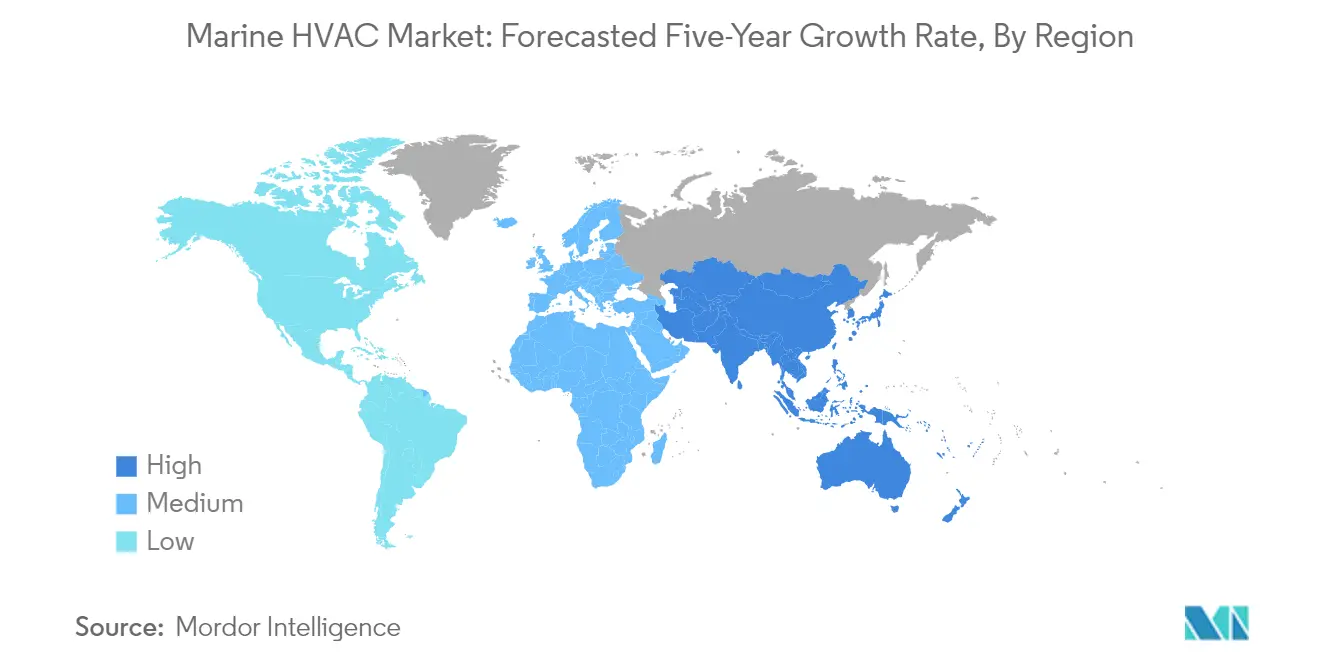
Marine HVAC Market in United States
The United States dominates the North American marine HVAC market through its extensive network of 154 active shipyards spread across 29 states and the United States Virgin Islands. With approximately 95% market share in North America for 2024, the country's marine HVAC sector benefits from robust government support, including the 30-year shipbuilding plan for naval vessel procurement. The market is further strengthened by significant investments in port infrastructure, growing maritime trade activities, and increasing focus on vessel modernization programs. The presence of major marine HVAC companies and their strong distribution networks also contributes to market growth, while stringent environmental regulations drive demand for energy-efficient HVAC systems.
Marine HVAC Market Growth Trajectory in United States
The United States continues to demonstrate strong growth potential with an expected growth rate of approximately 3% during 2024-2029. This growth is driven by increasing investments in maritime infrastructure, rising demand for advanced marine HVAC systems in naval vessels, and growing emphasis on energy-efficient solutions. The expansion is supported by federal funding initiatives for port modernization and vessel upgrade programs, coupled with increasing adoption of smart HVAC technologies. The market also benefits from growing cruise industry operations and increasing focus on passenger comfort and safety requirements.
Marine HVAC Market in Europe
The European marine HVAC market showcases significant diversity with strong contributions from Germany, the United Kingdom, France, and Spain. The region's maritime sector benefits from extensive shipbuilding heritage, advanced technological capabilities, and a strong focus on sustainable marine solutions. Each country brings unique strengths to the market, with Germany's robust shipbuilding industry, the UK's maritime security focus, France's extensive coastline operations, and Spain's significant fishing fleet contributing to overall market dynamics.
Marine HVAC Market in Germany
Germany leads the European marine HVAC market with approximately 19% market share in 2024, supported by its position as one of the world's leading maritime nations. The country's marine sector generates substantial annual turnover and employs hundreds of thousands of workers across various maritime operations. With more than 360 shipping companies operating around 2,700 seagoing vessels, Germany maintains a strong position in container shipping capacity worldwide. The country's nine major shipyards and approximately 2,800 companies active in shipbuilding and ocean industries create sustained demand for marine HVAC systems.
Marine HVAC Market Growth Trajectory in United Kingdom
The United Kingdom demonstrates the highest growth potential in the European region with an expected growth rate of approximately 3% during 2024-2029. The country's strategic focus on maritime security and extensive maritime trade operations drives continuous demand for marine HVAC systems. With almost 95% of UK imports and exports moving by sea through over 400 British ports, the market shows strong potential for sustained growth. The country's commitment to maritime sector development and increasing focus on sustainable shipping solutions further supports market expansion.
Marine HVAC Market in Asia-Pacific
The Asia-Pacific region represents a dynamic market for marine HVAC systems, with significant contributions from China, Japan, South Korea, and India. The region's dominance in global shipbuilding, particularly from China, Japan, and South Korea, creates substantial demand for marine HVAC systems. Each country brings unique strengths to the market, with China's massive shipbuilding capacity, Japan's technological advancement, South Korea's focus on high-value ships, and India's growing maritime ambitions.
Marine HVAC Market in China
China maintains its position as the largest market in the Asia-Pacific region, supported by its dominant position in global shipbuilding and extensive maritime operations. The country's maritime industry demonstrates remarkable success with extensive container throughput and a leading position in global shipbuilding orders. China's strategic geographical location, extensive coastline, and continued investment in maritime infrastructure reinforce its market leadership.
Marine HVAC Market Growth Trajectory in India
India emerges as the fastest-growing market in the Asia-Pacific region, driven by ambitious maritime development plans and increasing investments in shipbuilding capabilities. The country's extensive coastline, growing fleet strength, and strategic focus on maritime sector development create substantial growth opportunities. India's commitment to expanding its maritime infrastructure and modernizing its vessel fleet supports sustained market growth.
Marine HVAC Market in Latin America
The Latin American marine HVAC market encompasses key maritime nations including Mexico, Brazil, and Argentina, each contributing to regional market development. Brazil emerges as the largest market driven by its extensive network of river lakes and coastline, while Mexico shows the fastest growth potential supported by its strategic location and growing maritime tourism sector. The region's focus on developing port infrastructure, expanding fishing fleets, and modernizing naval vessels creates sustained demand for marine HVAC systems.
Marine HVAC Market in Middle-East & Africa
The Middle-East & Africa marine HVAC market is characterized by strong maritime activities in the United Arab Emirates and Saudi Arabia. The UAE leads the regional market with its position as a global maritime hub and extensive port infrastructure, while Saudi Arabia shows the fastest growth supported by significant investments in maritime sector development. The region's strategic location, growing maritime trade, and expansion of offshore HVAC activities continue to drive demand for marine HVAC systems.
Competitive Landscape
Top Companies in Marine HVAC Market
The marine HVAC market is characterized by the strong presence of established global players like Dometic Group, Carrier Corporation, Daikin Industries, Johnson Controls, and GEA Group, who dominate through their comprehensive product portfolios and extensive geographical reach. These industry leaders are increasingly focusing on product innovation, particularly in developing energy-efficient and environmentally sustainable HVAC solutions tailored for various vessel types. Companies are strengthening their market positions through strategic partnerships with shipbuilders and expanding their service networks to provide comprehensive maintenance support. The competitive landscape is witnessing a growing emphasis on technological advancement, with companies investing in smart HVAC systems featuring IoT integration and advanced air filtration capabilities. Operational agility has become crucial as manufacturers adapt to evolving maritime regulations and changing customer preferences, while strategic expansion moves are primarily focused on emerging markets in the Asia-Pacific and Middle East regions.
Consolidated Market with Strong Global Players
The marine HVAC market structure is characterized by a relatively consolidated landscape where global conglomerates maintain significant market share through their established brand reputation and technological capabilities. These major players leverage their extensive research and development facilities, manufacturing capabilities, and worldwide distribution networks to maintain their competitive edge. The market demonstrates high entry barriers due to the requirement for specialized technical expertise, substantial capital investments, and the need for long-standing relationships with shipbuilders and marine vessel operators. Regional players typically focus on specific market niches or geographical areas, often competing through specialized solutions and local service capabilities.
The industry has witnessed strategic mergers and acquisitions as companies seek to enhance their technological capabilities and expand their geographical presence. Major players are increasingly pursuing vertical integration strategies to strengthen their control over the supply chain and improve operational efficiency. The competitive dynamics are further shaped by the formation of strategic alliances between HVAC manufacturers and shipbuilding companies, creating long-term supply partnerships. These collaborations often extend beyond simple supplier relationships to include joint development of customized solutions and integrated systems for specific vessel types.
Innovation and Service Excellence Drive Success
Success in the marine HVAC market increasingly depends on companies' ability to develop innovative, energy-efficient solutions while maintaining strong service networks. Market leaders are strengthening their positions by investing in advanced manufacturing technologies, developing smart HVAC systems with predictive maintenance capabilities, and expanding their aftermarket service offerings. Companies are also focusing on building comprehensive product portfolios that can address diverse vessel requirements while ensuring compliance with stringent environmental regulations. The ability to provide integrated solutions, including installation, maintenance, and retrofit services, has become a crucial differentiator in the market.
For new entrants and smaller players, success lies in identifying and serving specific market niches where they can build expertise and differentiated offerings. This includes focusing on particular vessel types, geographical regions, or specialized technological solutions. The increasing emphasis on environmental sustainability and energy efficiency creates opportunities for innovative companies to challenge established players with new technologies and solutions. Building strong relationships with shipyards and vessel operators, developing efficient service networks, and maintaining flexibility in adapting to changing market requirements are essential factors for sustainable growth in this competitive landscape.
Marine Hvac Industry Leaders
Carrier Corporation
Daikin Industries
Johnson Controls
Brownswerk Marine Inc
Drews Marine GmbH
- *Disclaimer: Major Players sorted in no particular order
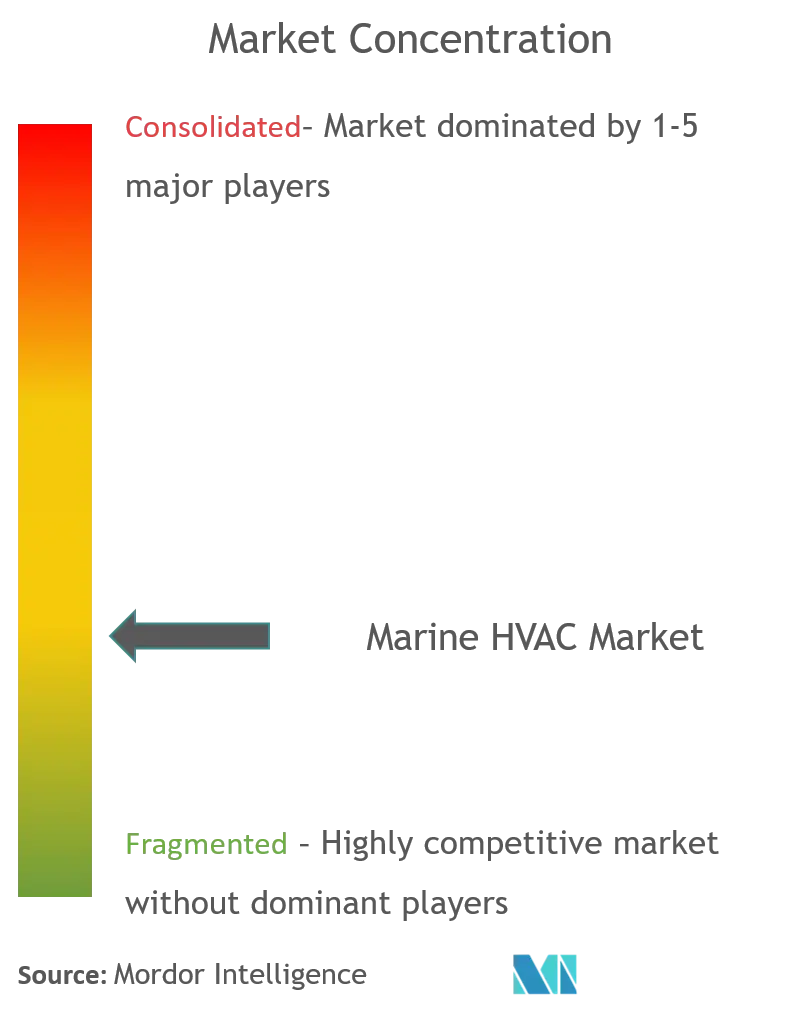
Global Marine Hvac Market Report Scope
Marine HVAC Market is Segmented by Vessel Type (Passenger Vessels, Cargo Carriers, Fishing Vessels, Other Vessel Types), By Technology Type (Marine Ventilation Systems, Marine Air Conditioning, Marine Heating Systems, Marine Refrigeration Systems), By Application (Engine Room, Cargo Hold, Deck, Tender Garage, and Others), By Capacity (Less than 20 RT, 20-90 RT, Above 90 RT), and by Geography (North America, Europe, Asia Pacific, and Rest of the World).
| Passenger Vessels |
| Cargo Carriers |
| Fishing Vessels |
| Other Vessel Type |
| Marine Ventilation Systems |
| Marine Air Conditioning |
| Marine Heating Systems |
| Marine Refrigeration Systems |
| Less than 20 RT |
| 20 - 90 RT |
| Above 90 RT |
| Engine Room |
| Cargo Hold |
| Deck |
| Tender Garage |
| Other |
| North America | United States |
| Canada | |
| Rest of North America | |
| Europe | Germany |
| United Kingdom | |
| France | |
| Spain | |
| Rest of Europe | |
| Asia Pacific | India |
| China | |
| Japan | |
| Rest of Asia-Pacific | |
| Latin America | Mexico |
| Brazil | |
| Argentina | |
| Middle-East and Africa | United Arab Emirates |
| Saudi Arabia | |
| Rest of Middle-East and Africa |
| Vessel Type | Passenger Vessels | |
| Cargo Carriers | ||
| Fishing Vessels | ||
| Other Vessel Type | ||
| Technology Type | Marine Ventilation Systems | |
| Marine Air Conditioning | ||
| Marine Heating Systems | ||
| Marine Refrigeration Systems | ||
| Capacity | Less than 20 RT | |
| 20 - 90 RT | ||
| Above 90 RT | ||
| Application | Engine Room | |
| Cargo Hold | ||
| Deck | ||
| Tender Garage | ||
| Other | ||
| Geography | North America | United States |
| Canada | ||
| Rest of North America | ||
| Europe | Germany | |
| United Kingdom | ||
| France | ||
| Spain | ||
| Rest of Europe | ||
| Asia Pacific | India | |
| China | ||
| Japan | ||
| Rest of Asia-Pacific | ||
| Latin America | Mexico | |
| Brazil | ||
| Argentina | ||
| Middle-East and Africa | United Arab Emirates | |
| Saudi Arabia | ||
| Rest of Middle-East and Africa | ||
Key Questions Answered in the Report
What is the current Marine Hvac Market size?
The Marine Hvac Market is projected to register a CAGR of greater than 3.5% during the forecast period (2025-2030)
Who are the key players in Marine Hvac Market?
Carrier Corporation, Daikin Industries, Johnson Controls, Brownswerk Marine Inc and Drews Marine GmbH are the major companies operating in the Marine Hvac Market.
Which is the fastest growing region in Marine Hvac Market?
Asia Pacific is estimated to grow at the highest CAGR over the forecast period (2025-2030).
Which region has the biggest share in Marine Hvac Market?
In 2025, the North America accounts for the largest market share in Marine Hvac Market.
What years does this Marine Hvac Market cover?
The report covers the Marine Hvac Market historical market size for years: 2019, 2020, 2021, 2022, 2023 and 2024. The report also forecasts the Marine Hvac Market size for years: 2025, 2026, 2027, 2028, 2029 and 2030.
